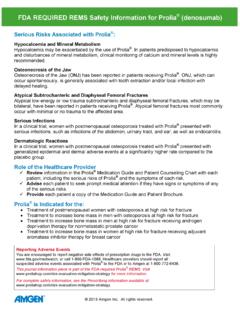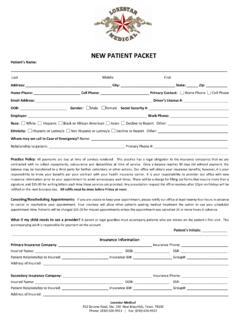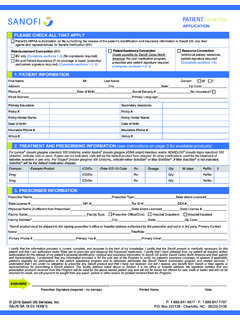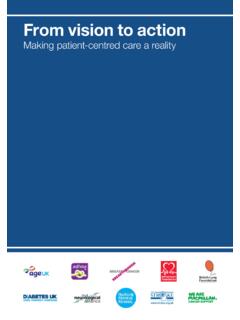Transcription of Insurance Verification and Prior Authorization Form ...
1 Prolia 60 mg pre-filled syringe, 60 mg SC every 6 months Refill: x1 x2 x3 x4 Prescriber Signature: (required for legal prescription triage) _____Date: _____Patient s Scheduled Injection Date: (Age-related osteoporosis without current pathological fracture) _____ (Age-related osteoporosis with current pathological ) Please provide complete code Other (specify ICD Code) _____ Please provide secondary ICD Code, if applicable: _____ Original Diagnostic T-Score: _____ T-Score Date: _____ History of osteoporotic fracturePrior Osteoporosis Therapy (if any): Generic alendronate Fosamax (alendronate sodium) Actonel (risedronate sodium) Boniva (ibandronate sodium) Other _____Reason for Discontinuing Previous Osteoporosis Therapy(ies):_____Contraindications (if any):_____Patient is currently taking calcium and vitamin D supplements: Ye s NoCalcium level available: Ye s NoOther pertinent information : _____ The sample diagnosis codes are informational and not intended to be directive or a guarantee of reimbursement and include potential codes that would include FDA approved indications for Prolia.
2 Other codes may be more appropriate given internal system guidelines, payer requirements, practice patterns, and the services rendered.*Physician Name: _____*NPI #: _____Tax ID #: _____Specialty: _____*Enter Site ID: _____OR Complete information below.*Site Name: _____*Street Address: _____*City: _____*State: _____*ZIP: _____*Phone: _ _____Fax: _____Office Contact: _____*Site Type: MD Office Hospital OutpatientInsurance Verification and Prior Authorization FormFax with copies of Insurance card(s), front and back, to Amgen Assist : 1-877-877-6542*Asterisk fields are required for processing. If you have any questions, please contact Amgen Assist at 1-866-AMG-ASST (1-866-264-2778).Please see Indications and Important Safety information on page 2, and the accompanying Prolia full Prescribing information , including Medication completing and faxing this form, you represent that your patient is aware of the disclosure of their personal health information to Amgen and its agents for Amgen s patient support services, including reimbursement and Verification services and the services provided by field reimbursement professionals in your office, as part of the patient s treatment with this product and that you have obtained appropriate patient authorizations as Completed Form and/or Copy of Insurance Card(s) to Amgen Assist : 1-877-877-6542.
3 2020 Amgen Inc. All rights reserved. Trademarks are properties of respective owners. USA-162-82122 04/20*Patient Name: _____ Attach patient demographic sheet OR Complete information below:*Street Address: _____*City: _____*State: _____*ZIP: _____*Phone: _____M F *Date of Birth: _____ Patient information Physician information (Defaults to Medical Benefit) Medical and Pharmacy Benefit Medical Benefit (Physician Purchase) Referral to treating site:*Enter Site ID: _____ OR Complete information below. *Site Name: _____*Street Address: _____*City: _____*State: _____*ZIP: _____*Phone: _ _____*Fax: _____Office Contact: _____*Site Type: MD Office Hospital Outpatient Fulfillment Method (Select only ONE) Attach a copy of Insurance card, front AND back OR provide:* Insurance Name: _____* Insurance Phone: _____Subscriber Name: _____Subscriber Date of Birth: _____Subscriber Relationship to Patient: _____Group #: _____*Policy #: _____ Primary Insurance information Attach a copy of Insurance card, front AND back OR provide:*Pharmacy Insurance Patient ID #: _____*Pharmacy Insurance Phone #: _____ Pharmacy Insurance information Prescription information Injection Date Attach a copy of Insurance card, front AND back OR provide:* Insurance Name: _____*Is this a Medigap policy?
4 Ye s No Not KnownIf yes, please indicate plan letter: _____* Insurance Phone: _____Subscriber Name: _____Subscriber Date of Birth: _____Subscriber Relationship to Patient: _____Group #: _____*Policy #: _____Secondary Insurance information (If Applicable) Patient Medical information Amgen Inc. One Amgen Center Drive Thousand Oaks, CA 91320-1799 2020 Amgen Inc. All rights reserved. USA-162-82122 04/20 Please see accompanying Prolia full Prescribing information , including Medication is indicated for the treatment of postmenopausal women with osteoporosis at high risk for fracture, defined as a history of osteoporotic fracture, or multiple risk factors for fracture; or patients who have failed or are intolerant to other available osteoporosis is indicated for treatment to increase bone mass in men with osteoporosis at high risk for fracture, defined as a history of osteoporotic fracture, or multiple risk factors for fracture; or patients who have failed or are intolerant to other available osteoporosis Safety information Contraindications: Prolia is contraindicated in patients with hypocalcemia.
5 Pre-existing hypocalcemia must be corrected Prior to initiating Prolia . Prolia is contraindicated in women who are pregnant and may cause fetal harm. In women of reproductive potential, pregnancy testing should be performed Prior to initiating treatment with Prolia . Prolia is contraindicated in patients with a history of systemic hypersensitivity to any component of the product. Reactions have included anaphylaxis, facial swelling and urticaria. Same Active Ingredient: Prolia contains the same active ingredient (denosumab) found in XGEVA . patients receiving Prolia should not receive XGEVA . Hypersensitivity: Clinically significant hypersensitivity including anaphylaxis has been reported with Prolia . Symptoms have included hypotension, dyspnea, throat tightness, facial and upper airway edema, pruritus and urticaria. If an anaphylactic or other clinically significant allergic reaction occurs, initiate appropriate therapy and discontinue further use of Prolia.
6 Hypocalcemia: Hypocalcemia may worsen with the use of Prolia , especially in patients with severe renal impairment. In patients predisposed to hypocalcemia and disturbances of mineral metabolism, including treatment with other calcium-lowering drugs, clinical monitoring of calcium and mineral levels is highly recommended within 14 days of Prolia injection. Concomitant use of calcimimetic drugs may worsen hypocalcemia risk and serum calcium should be closely monitored. Adequately supplement all patients with calcium and vitamin D. Osteonecrosis of the Jaw (ONJ): ONJ, which can occur spontaneously, is generally associated with tooth extraction and/or local infection with delayed healing, and has been reported in patients receiving Prolia . An oral exam should be performed by the prescriber Prior to initiation of Prolia . A dental examination with appropriate preventive dentistry is recommended Prior to treatment in patients with risk factors for ONJ such as invasive dental procedures, diagnosis of cancer, concomitant therapies ( chemotherapy, corticosteroids, angiogenesis inhibitors), poor oral hygiene, and co-morbid disorders.
7 Good oral hygiene practices should be maintained during treatment with Prolia . The risk of ONJ may increase with duration of exposure to Prolia . For patients requiring invasive dental procedures, clinical judgment should guide the management plan of each patient. patients who are suspected of having or who develop ONJ should receive care by a dentist or an oral surgeon. Extensive dental surgery to treat ONJ may exacerbate the condition. Discontinuation of P r o l i a should be considered based on individual benefit-risk assessment. Atypical Femoral Fractures: Atypical low-energy, or low trauma fractures of the shaft have been reported in patients receiving Prolia . Causality has not been established as these fractures also occur in osteoporotic patients who have not been treated with antiresorptive agents. During Prolia treatment, patients should be advised to report new or unusual thigh, hip, or groin pain.
8 Any patient who presents with thigh or groin pain should be evaluated to rule out an incomplete femur fracture. Interruption of Prolia therapy should be considered, pending a risk/benefit assessment, on an individual basis. Multiple Vertebral Fractures (MVF) Following Discontinuation of Prolia Treatment: Following discontinuation of Prolia treatment, fracture risk increases, including the risk of multiple vertebral fractures. New vertebral fractures occurred as early as 7 months (on average 19 months) after the last dose of Prolia . Prior vertebral fracture was a predictor of multiple vertebral fractures after Prolia discontinuation. Evaluate an individual s benefit/risk before initiating treatment with Prolia . If Prolia treatment is discontinued, patients should be transitioned to an alternative antiresorptive therapy. Serious Infections: In a clinical trial (N = 7808) in women with postmenopausal osteoporosis, serious infections leading to hospitalization were reported more frequently in the Prolia group than in the placebo group.
9 Serious skin infections, as well as infections of the abdomen, urinary tract and ear, were more frequent in patients treated with Prolia . Endocarditis was also reported more frequently in Prolia -treated patients . The incidence of opportunistic infections and the overall incidence of infections were similar between the treatment groups. Advise patients to seek prompt medical attention if they develop signs or symptoms of severe infection, including cellulitis. patients on concomitant immunosuppressant agents or with impaired immune systems may be at increased risk for serious infections. In patients who develop serious infections while on Prolia , prescribers should assess the need for continued Prolia therapy. Dermatologic Adverse Reactions: In the same clinical trial in women with postmenopausal osteoporosis, epidermal and dermal adverse events such as dermatitis, eczema and rashes occurred at a significantly higher rate with Prolia compared to placebo.
10 Most of these events were not specific to the injection site. Consider discontinuing Prolia if severe symptoms develop. Musculoskeletal Pain: Severe and occasionally incapacitating bone, joint, and/or muscle pain has been reported in patients taking Prolia . Consider discontinuing use if severe symptoms develop. Suppression of Bone Turnover: In clinical trials in women with postmenopausal osteoporosis, Prolia resulted in significant suppression of bone remodeling as evidenced by markers of bone turnover and bone histomorphometry. The significance of these findings and the effect of long-term treatment are unknown. Monitor patients for consequences, including ONJ, atypical fractures, and delayed fracture healing. Adverse Reactions: The most common adverse reactions (> 5% and more common than placebo) in women with postmenopausal osteoporosis are back pain, pain in extremity, musculoskeletal pain, hypercholesterolemia, and cystitis.






